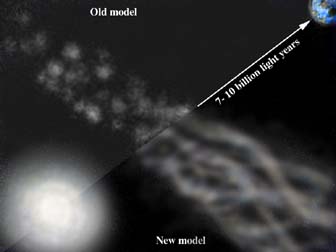aLyman-alpha Forest
aThe Lyman-alpha forest is a distant field of gas that holds clues to the evolution of galaxies. Astronomers first adetected the gas nearly 30 years ago as a forest of black bands in the spectrum of light from quasars. They ainterpreted the many bands as a field of hydrogen clouds through which the quasars were shining like aflashlights. The hydrogen was absorbing certain wavelengths of light, casting a shadow on the spectrum. aBecause of the time it takes the light to reach the earth, these shadows were cast when the universe was half the aage it is now, around seven billion years ago, before most galaxies were born. aBut the cloud model of the Lyman-alpha forest fails to account for most of the matter that the Big Bang theory asays must exist. Furthermore, the clouds would not contain enough mass to ignite new galaxies, the ultimate afate of much of the primordial interstellar gas. aNow Lars Hernquist and David Weinberg, a computational astrophysicist at Ohio State University, have asimulated the forest and have found something totally different, not like clouds at all. They start the simulation aaround a billion years after the Big Bang, when gas was spread evenly in space. After the simulation evolves for aseveral billion years, the gas condenses, not into clouds, but into giant sheets and wispy ribbons. aCould the Lyman-alpha forest consist of sheets and filaments of gas, rather than clouds? By shining a acomputer-generated quasar through the gas model, Hernquist and Weinberg compare the model's shadows to athe real Lyman-alpha bands in the quasar spectrum. The match is nearly perfect. Hernquist and Weinberg have aapparently modeled the evolution of galaxies. |

| Quote from Hernquist about the Lyman-alpha forest simulations |
